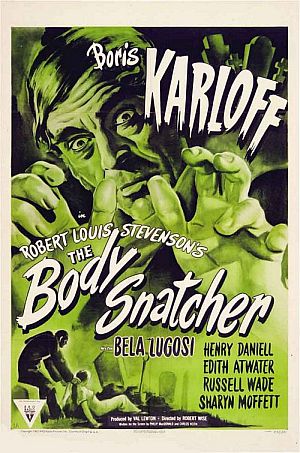 This entry is for the Val Lewton Blogathon, going on now! Head on over to Speakeasy and Classic Movie Man to read the other entries.
This entry is for the Val Lewton Blogathon, going on now! Head on over to Speakeasy and Classic Movie Man to read the other entries.
There are spoilers for The Body Snatcher, my friends. Many spoilers. This is a film you want to watch unspoiled if possible.
***
By 1830, the industrial revolution had finally come to Scotland, and with this increased need for labor in urban areas came a series of unsurprising problems: Overcrowding, squalor, class tensions and poverty.
It is this world which Mr. Grey, the unlikely Charon of Edinburgh, makes his own. In the dead of night he steals the bodies of the recently deceased from their graves, selling them for £10 per — a luxurious sum — to local doctor Wolfe MacFarland who needs, or maybe just wants, them for his research and his medical students.
The Body Snatcher (1945) was only the fourth film directed by Robert Wise, though he already had a notable career as an editor on such films as Citizen Kane, The Magnificent Ambersons, My Favorite Wife and The Devil and Daniel Webster; he occasionally directed films, too, such as Curse of the Cat People. Though he was a talented director, he was still somewhat adrift in 1945, his signature style not yet formed — or, as some would say, he had not yet “borrowed” enough techniques from other directors to fully amalgamate into a style he could call his own. Thus The Body Snatcher is a well-crafted film that reveals producer Val Lewton’s vision rather than Wise’s, and we are all better off for it.
Lewton had a terrific run of horror films in the 1940s, producing 11 in only four years. Yet in 1945, just three years into his relatively short career, his luck was already starting to turn. Two films the prior year, Mademoiselle Fifi and Youth Runs Wild, were lesser films in his oeuvre, failing to capture either the public’s imagination or the critics’ favor. But Lewton managed to garner the attention of Boris Karloff, interested in turning his typecast career into something greater than a simple Frankenstein legacy, and with that in mind, Lewton turned his own hand to writing. The result was three outstanding horror films in quick succession; The Body Snatcher was the first.
It was also the last of the horror films with the dynamic duo of Karloff and Bela Lugosi paired together. Between Karloff’s career trajectory going up and Lugosi’s personal and professional life faltering, the two would never have chance to meet again on the big screen.
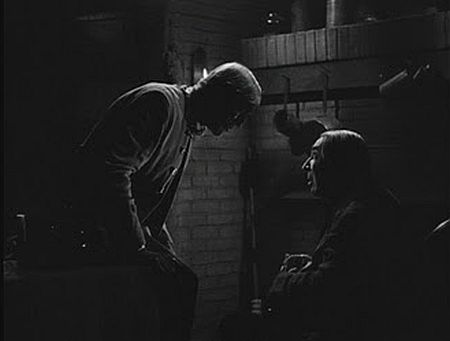 (Picture courtesy From Midnight, With Love.)
(Picture courtesy From Midnight, With Love.)
In truth, the character of Joseph played by Lugosi in The Body Snatcher is superfluous. Bela was already showing the effects of drink and drugs, the puffiness, strange wide eyes and the constant vague smile. Just a few years earlier in The Phantom Creeps, Bela was agile enough to do a few stunts, but in TBS, there are times when he looks barely able to walk. It is with his character Joseph that we get the slightly non sequitur but still delightfully homoerotic fight scene between him and Mr. Grey, though surely the scene was performed with stunt men. No stunts were used in the following scene of Joseph’s body floating underwater, however. That face slightly distorted from the deflected light is Lugosi’s own, a fittingly freakish end to a horror partnership for the ages.
Mr. Grey, played with relish by Boris Karloff, has a much larger role than in the original Robert Lewis Stevenson story the film is based on. Stevenson’s tale is a short one, barely 20 pages in most volumes, and characters have been changed, as is the usual way with Hollywood.
Our main character, the earnest and innocent young medical student Donald Fettes, is played by Russell Wade. The pleasant but bland Okie was an uncredited contract man with RKO for years, finally getting secondary but credited roles after the end of WWII. TBS was one of his final films; he retired from acting at age 30, possibly finally realizing he had very little talent for it, but not without having this one lasting moment on celluloid.
Fettes is student to Dr. Wolfe MacFarland, played by a delicious Henry Daniell. In the original story, Fettes and MacFarland were students together, Fettes now aged by drink and sin, with MacFarland looking much younger, but also much richer, than Fettes. In this adaptation of the story, MacFarland is indeed well off. He has fine suits with jeweled buttons, lush fabrics and an ostentatious watch fob of diamonds dangling from his vest.
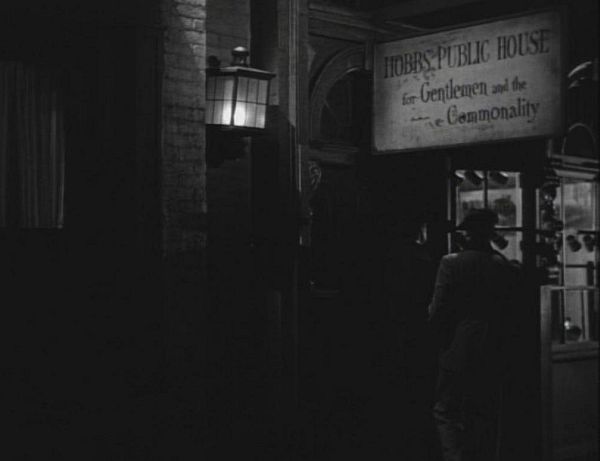 (Screencap generously provided by The Mike of From Midnight, With Love.)
(Screencap generously provided by The Mike of From Midnight, With Love.)
Very little is directly made of the class distinctions in the film until the final showdown between the two leads, though Mr. Grey, corpse supplier to Dr. MacFarland, does indulge in some mock surprise when his old friend “Toddy” — a nickname MacFarland loathes — deigns to have a drink with “the commonality.”
A situation arises when Georgina, a young girl who cannot walk, is brought to Dr. MacFarland by her mother. She has been all over the world to see specialists in hopes of finding one who can cure her daughter of an injury suffered a few years earlier. MacFarland feels he can cure her, but he’s too busy, he claims, what with being a teacher and all. Georgina is also scared of the man, who has all the bedside manner of an irritated garden snake, but she and her mother are both fond of Fettes. They ask him to help plead their case to MacFarland.
At the same time, Fettes is given an assistant position with MacFarland, helping to teach courses, which leads to him being let into the dirty little secret of body snatching. Dr. MacFarland defends well the need for scientific research in the face of silly superstition, but he has no room in his life for social custom, culture or even respect for those who have just buried their dead. He laments that there aren’t enough paupers dying to supply medical schools with research subjects. The classism is obvious enough when stated plainly, but MacFarland’s heated prose is subtle because it’s convincingly framed in the desire to save people. Still, one wonders how many people he wishes to save if he won’t even operate on one little girl.
Mr. Grey seems at first a jovial guy, a pleasant cab man by day with a white horse named Friend, a man who is merely making a living in a tough world by delivering souls to the scientific afterlife. But quickly Fettes realizes Grey and “Toddy” MacFarland have a past. He also discovers that Grey had, while digging up a child recently buried, killed the boy’s devoted dog. It’s a scene that has pathos, but is also viscerally disgusting, as the dog the devastated mother carries away looks both very real and very dead, its stiff tail not even bobbing as she steps. It’s one of the many cinematic hypocrisies in Hollywood that a film would kill a dog unnecessarily, simply for a short scene meant to portray a man as evil for killing a dog unnecessarily.
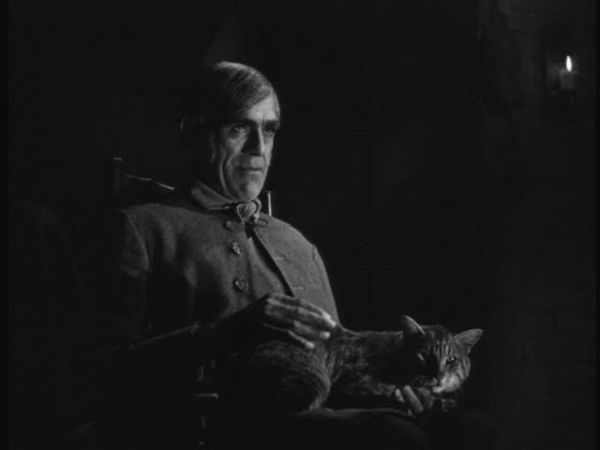 Nice fellow. Kind to cats. Snatches bodies.
Nice fellow. Kind to cats. Snatches bodies.
(Picture courtesy Only the Cinema.)
Screenwriter Philip MacDonald, who helped write great films like The Lost Patrol, Bride of Frankenstein and Rebecca before turning to television work in the 1950s, worked with Lewton in adapting Stevenson’s short story to film. While class plays a factor in the short story, Lewton and MacDonald elevated it to the primary focus for the film, though the horror was gritty enough and the class issues subtle enough that Body Snatcher works well without thought of class at all.
But social standing is really what Body Snatcher is about. When Fettes promises that MacFarland will operate on little Georgina, MacFarland raves, insisting he needs corpses to practice on before operating. There are no corpses, not until Grey decides to provide one, a beautiful young blind girl who walks the streets, singing for alms. It’s Georgina versus that poor blind street singer, and Grey has weighed their value to society, deeming one girl worth more than the other.
Dissections are of course never seen in this film — it was 1945, after all — but the ritual of preparing for dissection is gruesome enough. When the girl’s body arrives at MacFarland’s, Fettes is at first pleased, until he sees who it is and realizes what Grey has done. Yet MacFarland sees only a corpse he can practice on for the upcoming spinal surgery. He wants the “entire center” of this beautiful young girl’s body, telling Fettes “you know why.” He means of course the spinal cord for research, but he means more than that, and the scene fades out as the men slowly remove the cloth from her body.
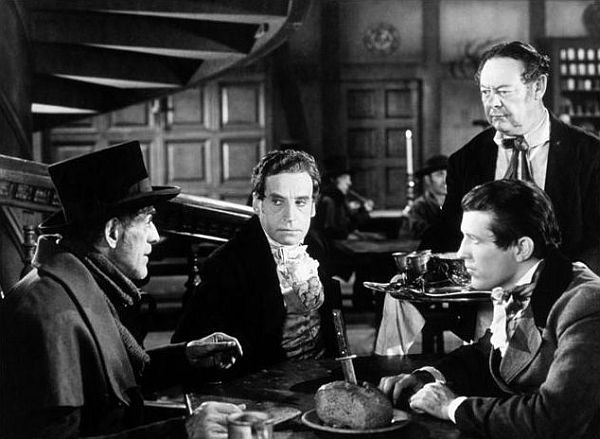 (Picture courtesy Screen Rush.)
(Picture courtesy Screen Rush.)
Grey’s name implies a middle ground, though there is hardly a middle ground to be had in the business of bodies. He is, however, between two socioeconomic worlds. His side business must make him far better off than most people at the time, though as a cab man by day and grave robber by night, he will never be anything but low class. He claims to believe every human being is equal in his eyes, but as the story unfolds, he makes it plain that he knows MacFarland is allowed to get away with these things because of his class and stature while Grey, if caught, would be jailed or worse. Yet Grey also casts himself to be above the rest of the commonality. He is more antisocial than a believer in social equality ought to be, thinking himself so superior that he can play executioner at will.
Daniell is exceptional in this role, playing the role as a confused and conflicted man until finally unleashing his silky-voiced ooze of superiority, dashing any sympathy we have for him by playing the social status card in an attempt to drive Grey out of his life. It’s a fascinating scene, a pair of sociopaths going head to head, and MacFarland’s audacious move seals his fate.
The Body Snatcher is confident film making, exchanging the usual trope of nighttime fog for daytime mist, allowing silence in place of dramatic scary music stings, and lingering shots that go on long after anyone has been in the frame. It is not only one of Lewton’s best films, it is one of the best films to come out of the 1940s.
Further Reading:
Big thanks to The Mike for sending me a screencap of the public house sign, plus (unknowingly) supplying me with the cap of Boris and Bela. Here’s his terrific review of The Body Snatcher from two years ago.
Only the Cinema’s excellent piece on The Body Snatcher
***
Note: During the writing of this post, my computer went tits up. Though my husband has kindly offered the services of his computer, it sadly does not possess a DVD drive, which is why I have basically stolen screencaps from other sites. Thank you to all of you who unknowingly saved my bacon, and I hope I’ve credited you properly.

One of life’s greatest treats is opening a box of chocolates and watching Karloff and Daniell spar in “The Body Snatcher”. It is like enjoying a great tenor/baritone duet in an opera.
They are terrific, aren’t they? In the final showdown in the pub they both escalate the scene so expertly that it’s visceral, it makes you as nervous as if you were watching a couple fight in real life. I love it.
Ah, The Body Snatcher! This was my first Boris Karloff movie! Although I was stupid and though Henry Daniell was Boris (he had a square jaw, just like Frankenstein, so I thought he was Karloff! haha!), and I though Bela Lugosi was Grey!
It’s been YEEEARS since I’ve seen this, so I can’t remember. Is Bela Lugosi in this movie much at all? Like I said, I thought he played Grey, so when I found out who he played, I was like “that guy who was in that one scene where he was strangled by Boris Karloff?!” Is he just in that one scene, or is he in more?
Bela has two very short scenes, one where he’s just lurking about, and one where he tells Grey he knows what’s going on. Actually, he may have a little more lurking about than I remember, but really, he’s hardly in the film at all until the scene you mention.
Thanks for taking part in the Val Lewton blogathon and for writing such an interesting piece. I love this movie and I do, too, relish the performances of Daniell and Karloff.
Thanks! And thanks to you both for hosting!
(I’m just glad I had this post mostly written before my computer conked out. I’m borrowing the husband’s computer right now, but I don’t use it too often because we would get divorced if we had to share one computer. I’m… I’m not really joking.)
Stacia writes: It is this world in which Mr. Grey, the unlikely Charon of Edinburgh, makes his own.
Man, right outta the gate, and then it just gets better.
This is some gorgeous writing, darlin, and I am awestruck. As I said, I was sure this wonderful movie was in good hands, and your explication of the classism underlying the relationship between McFarlane and Cabman Grey is right on. Grey has no end of fun with politely sneering at the concept because of his hold on the upperclass McFarlane due to their shared Burke and Hare past, and these are, as Caftan Woman says, some of the most electric scenes in the film.
Never get rid of me, never get rid of me, never get rid of me…
Many, many thanks for this piece.
Thanks for the very kind words, Chris!
“Never get rid of me” is the absolute perfect cadence, and it contrasts with the flopping white naked corpse enough that the viewer can distance themselves from the Super Incredibly Gross Thing that is happening at that moment. So terrific, I just love this film to pieces.
Like I said, Karloff really GLOWS in this role. The commentary track on the DVD tells me that Karloff was lubed up with luminous paint for that final scene in the coach, and there it all is in a nutshell: it’s among the most memorably creepy scenes in film, and all it took was an imaginative director and producer and a little luminous paint.
A hundred grand or so and what, maybe a six day shooting schedule. And just look at what they came up with. I’ll echo your comment, which can’t be said enough: I just love this film to pieces.